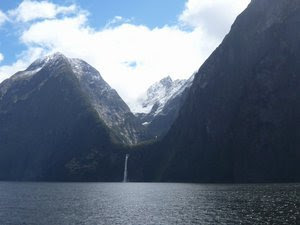Cirques
A cirque is an amphitheatre or arm chaired shaped hollow with a steep back wall and a rock basin. Several processes cause the underlying rocks to disintegrate. Plucking deepens the back wall, supply of water for freeze thaw and angular subglacial debris enables abrasion to deepen the floor of the cirque. A rock lip develops when erosion decreases. When the climate gets warmer, ice melts to leave a deep rounded lake or tarn.
Fig 1. Baffin Island, Nunavut, Canada
Aretes and pyramidal peaks
Two cirques erode backwards or sideways to each other to produce a narrow, steep-sided ridge called an arete.
Fig 2. Arete- Helvellyn
A pyramidal peak is formed, when three or more cirques develop on all sides of a mountain.
Fig 3. The Matterhorn, Pennine Alps
Glacial troughs, rock steps, truncuated steps and hanging valleys
As ice erodes the bottom and sides of a pre glacial valley valley over time, this process turns a V shaped valley into a U shaped valley. They are often known as glacial troughs and ovedeepening of a valley is due to the movement of ice, which is aided by large volumes of meltwater and subglacial debris. Compressing flow may overdeepen parts of the trough floor, producing narrow ribbon lakes later on or may leave less eroded, more resistant rock steps. Truncated spurs are formed when abrasion by englacial and subglacial debris and plucking along the sides of the valley remove the tips of pre-glacial interlocking spurs.
Fig 4. Valley of Lauterbrunnen, Switzerland
Small adjoining feeder valleys entering a large valley in a glaciated mountainous region tend to have their floors elevated some distance above the level of the main valley's floor. This is due to differentiated erosion between the main glacier and its tributary glaciers. The floor of any tributary is deepened at a slower rate, so that when the glacier melts it is left hanging high above the main valley.
Fig 5. Milford Sound, New Zealand
Striations, roche mountonnees and rock drumlins
Striations are scratches and grooves that are created by angular debris which is embedded in ice, that moves over exposed rock. A roche moutonnee is a mass of resistant rock, with a smooth, rounded up valley or stoss slope facing the direction of ice flow formed by abrasion. It also has a steep, jagged down valley or lee slope as a result of plucking. A rock drumlin is a more streamline bedrock, lacks the quarried lee face of the roche moutonee.
Fig 6. Roche Mountainee, Pennine Alps






No comments:
Post a Comment